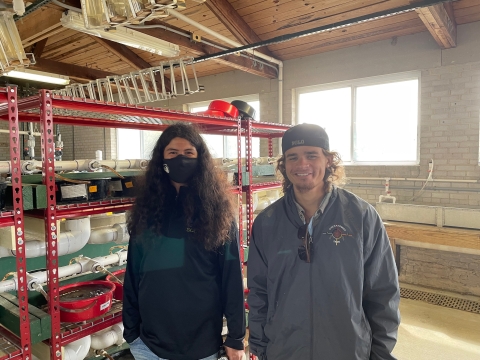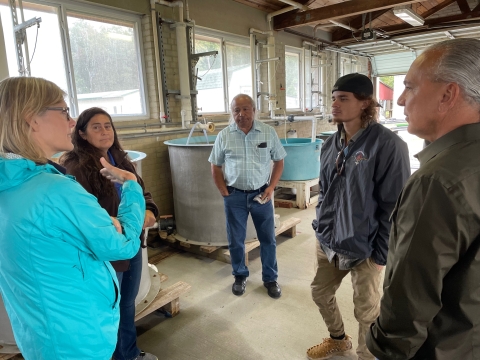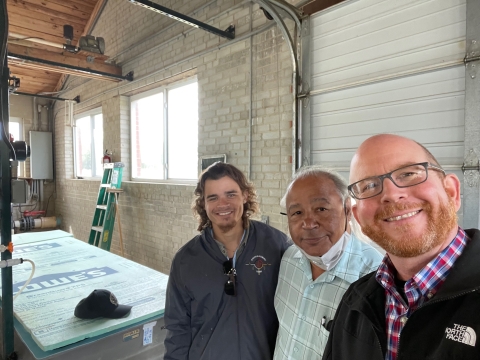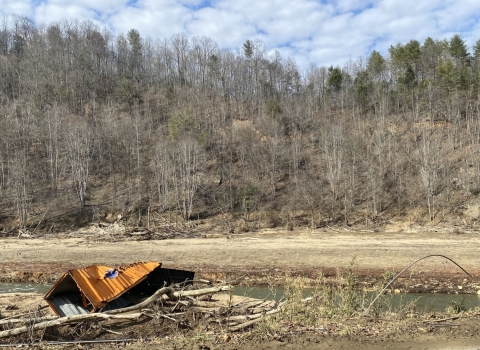They call the land Tsenacomacah — the Upper Mattaponi and their ancestors have been stewards of the land, the surrounding waters, the plants and wildlife since time immemorial.
Chesapeake Bay is the largest estuary in the United States—stretching from Cooperstown, New York to Norfolk, Virginia. In King William County, Virginia, the federally recognized Upper Mattaponi Indian Tribe is focused on restoring the lands and waters of this ecologically diverse region, including their namesake river, the Mattaponi.
Located near the James River in Virginia, Harrison Lake National Fish Hatchery has supported the restoration of migratory fishes in the Chesapeake Bay since the 1930s, producing and stocking millions of fish and mussels into rivers in Virginia and Maryland. Recently, the hatchery has partnered with the Upper Mattaponi Indian Tribe in an innovative relationship that closely aligns with the conservation missions of the U.S. Fish and Wildlife Service and the Tribe.
With the addition of two new Tribal hatchery technicians at Harrison Lake, the Service and the Tribe have joined together to share knowledge and experience in support of the Tribe opening a fish hatchery of their own. Here, the Tribal hatchery technicians are gaining an ecosystem-wide view of conservation and fish hatchery operations to continue the important work in the Chesapeake Bay. Their positions are supported by a Tribal Wildlife Grant administered by the Service’s Wildlife and Sport Fish Restoration program, enabling the Tribe to gain the expertise they will need to staff their own hatchery.
“The relationship is a natural partnership. Tribes are conservationists and we both care about the natural world and want to protect it,” explains Rachel Mair, project leader at Harrison Lake National Fish Hatchery. “Many of us feel this at our core both professionally and personally.”
Leigh Mitchell, environmental and cultural protection director for the Upper Mattaponi Indian Tribe, explained the Tribe's vision of building its own fish hatchery in the coming years. With American shad, river herring, and alewife all being culturally significant species in the Mattaponi River, restoring the river and its species to what they once were is an important priority for the Tribe.
“The Tribe’s traditions and culture revolve around the water and species here,” said Mitchell. “The Tribe needs to build their workforce and internal capacity, to build a sovereign nation from the ground up.”
Johnathan Oxendine of the Haliwa-Saponi Indian Tribe in North Carolina and Lane Eubank of the Chickahominy Tribe in Virginia were hired by the Upper Mattaponi Indian Tribe to help build that capacity and gain useful skills to one day run and support the Upper Mattaponi fish hatchery operations. Oxendine and Eubank support vital mussel conservation work at Harrison Lake while also focusing on their own research projects with the Upper Mattaponi.
Oxendine has tailored his Harrison Lake experience to include outreach and environmental education in addition to his work with mussel and fish propagation. He discovered that there are many ways to support Tribal conservation and expand his expertise. The work he’s accomplished at the hatchery is an important steppingstone. His interests include giving back to the Mattaponi Tribe for the opportunities they have provided him, and to continue sharing what he has learned, perhaps through a career in teaching.
“This has been an amazing opportunity and I’ve really enjoyed the people, the experiences, and working with mussels,” he explained. “I hope to continue to develop skills and be relevant to the Upper Mattaponi hatchery whether it be through outreach, education, data management or hatchery operations.”
Eubank has a strong interest in the restoration of native fish species as well as hunting and fishing traditions. He dreams of a career in conservation. In addition to his work with mussels, Eubank is researching shad in the Mattaponi River, working with local communities, and gaining experience with new organizations to collaborate on restoration in the bay.
“American shad and river herring are beautiful fish; they mean a lot to our Tribe. I’m drawn to how sensitive the fish are and how hard it is to raise those fish,” Eubank said. “I would love to see all the Tribes and all the national fish hatcheries work together to share our knowledge and get our rivers back to the way nature intended.”
Eubank expressed that he enjoys fishing but emphasized its importance to the Tribe’s subsistence. American shad serve as an important food source for Eubank’s family and his Tribe. Restoring shad populations will support the health of many other fish species that rely on them as well.
The Upper Mattaponi Indian Tribe is getting closer to their goal of having their own fish hatchery in the next few years and are already working to secure a property and drawing up designs for their hatchery.
“The Upper Mattaponi can now be stewards of the lands and waters in ways that align with their values,” explains Mitchell. “They now will have a seat at the table when it comes to restoring this valuable watershed.”
Working towards a common goal to restore culturally significant fish species and preserve this diverse landscape is seen as crucial for future generations.
“This is a new era of possibility for relationships between the federal government and Tribal Nations,” says the Service’s Regional Tribal Liaison, Tim Binzen. “We’re seeking opportunities for co-stewardship with Tribes, where we share similar conservation objectives for fish and wildlife. The Tribal internships at the national fish hatchery are an exciting example of working together in this way.”
Thanks to the coordination of Oxendine and Eubank, the Upper Mattaponi, Harrison Lake National Fish Hatchery, and the Tribal Wildlife Grant, offered through the Service’s Wildlife and Sport Fish Restoration program, the vision the Tribal fish hatchery is becoming a reality and will be instrumental in the restoration of migratory fish in the Mattaponi River.
“Our unique partnership with the Upper Mattaponi as a great model for how we can support Tribes and hatcheries throughout the region,” says Mair. “We are looking forward to expanding our knowledge and our network with Tribes in our future work.”





